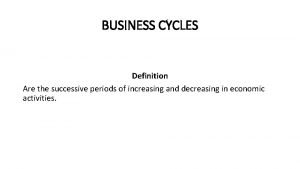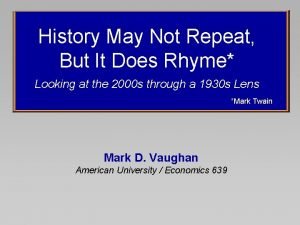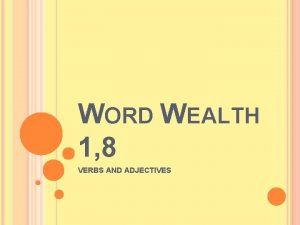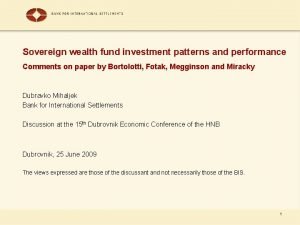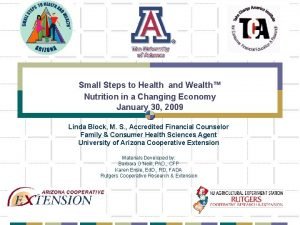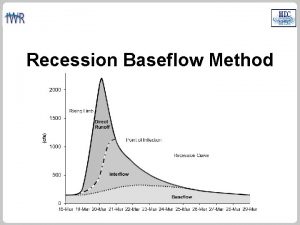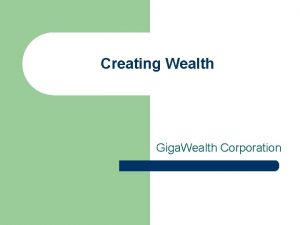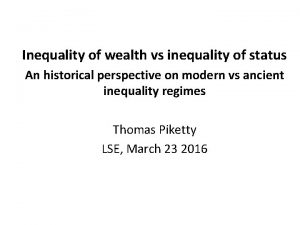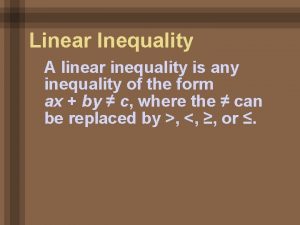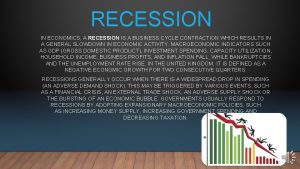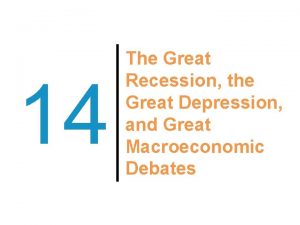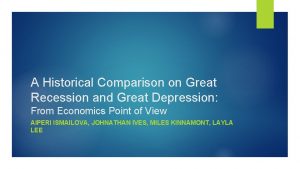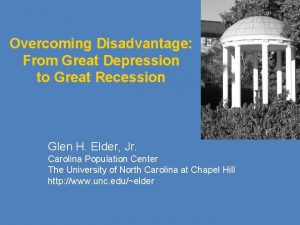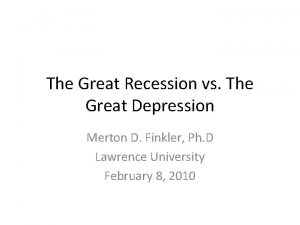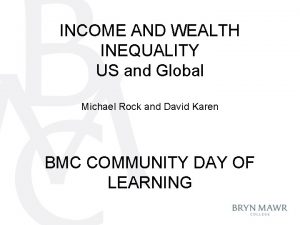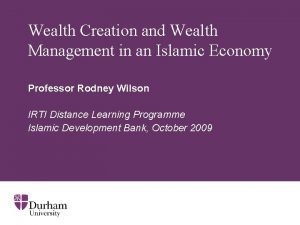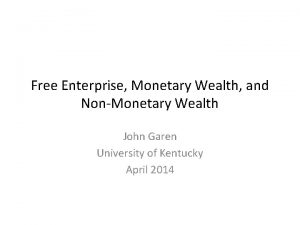Wealth inequality and the Great Recession Evidence from




























- Slides: 28

Wealth inequality and the Great Recession: Evidence from Sweden Jacob Lundberg and Daniel Waldenström Uppsala University Presentation at Mi. SOC/ISER, September 16, 2014 1

The economy in Sweden 1999 -2012 U and Y Disposable income Gini 2

This paper Two main objectives: • First, estimate of wealth distribution in Sweden since 2008. – Wealth tax repealed in 2007, Property tax reformed in 2008 – No household wealth data exist after 2007 in Sweden! • Second, study role of Great Recession for wealth distribution – Shocks to output, growth, unemployment and stock prices – Were the rich able to escape the crisis or did they take the strongest blow? – Did crisis experiences differ among the rich, across occupations etc? Paper structure • Estimating private assets and liabilities • Estimate wealth distribution 1999 -2012 3

Recent research on other countries • United States – Wolff (SCF, 2012): "Asset price meltdown for the middle class" • Plummeting house prices main explanation – Saez and Zucman (2014): "Wealth inequality is making a comeback" • New estimates using capitalized capital income • Germany: – Grabka and Westermeier (GSOEP, 2014): Small changes in both wealth levels and household wealth inequality 4

Data • Database: LINDA – 3, 35% nationally representative sample (300, 000 individuals) – Panel – Household members added (in total about 800, 000 obs) • Wealth data sources – Wealth Register 1999 -2007 – Other registers 2008 - (Income and Tax Register, Property Tax Register, Land survey register) • Additional information – Firm-specific dividends (SIX financial market information) – Financial Accounts (macro aggregate on household financial balances) 5

Results Part I: New estimates of individual wealth 2008‒ 2012 6

Estimating individuals' wealth in 2008 -2012 • We use different approaches – – Observed actual stocks (non-financial assets, debts) Observed dividend income and payout/share Regression-based "Investment income method" Chain with price changes assuming no transactions • Calibrate model using "true" outcomes during 1999 -2007 • Problem: too little noise in imputed variables and is added noise independent of the variables – Rubin (1976), Pagan (1984), Dardanoni et al (2011) – We abstract from this issue so far • Compute inequality estimates on individuals (so far) 7

Estimation of real estate/property • 8

Average housing value: estimated vs actual 1200000 1000000 SEK 800000 600000 400000 200000 0 1997 1999 2001 2003 Average housing value in Wealth Register 2005 2007 2009 2011 2013 Our estimated average houseing value 9

Real estate estimations vs actual Mean Gini 10

Financial asset estimations, 2008 • 11

Bank deposit estimations vs actual Mean Gini 12

Estimation of listed shares • 13

Value of shares in 2007: Estimation / "Truth" Capitalization method (Dividend / rate of return) Our direct estimation 14

Estimation of other financial assets • Mutual funds – Problematic since dividends typically reinvested – We use value of 2007 and calculate forward using value indices – Assumes no net savings • Bonds and fixed-interest securities – Not fully covered. Premium lottery bonds not observed. – Use interest earnings to estimate value • Condominiums – Simple approach: Extrapolate individual's 2007 ownership using municipality price indices. Assuming no transactions! • Solvable using new Apartment Register at Statistics Sweden (Census 2011) 15

Estimation of liabilities • Two types of loans: State student loans (15%), Mortgages (85%) – We observe student loans • Mortgages are observed in Inteckningar/Pantbrev – Land Survey Register (Lantmäteriet) – By year, property and individual (incl. debt share) • Differs from capitalization method (Debt = interest payments/interest rate) 16

Liabilities projection vs actual Mean Gini 17

LIabilities in 2007: Estimation / "Truth" Capitalization method (Interest payment / rate of return) Our direct estimation from mortgage contracts 18

Results Part II: How did the wealth of Swedes fare during the Great Recession? 19

Results 1: How well do our estimations perform? • Average total wealth: Actual vs Estimated 800000 700000 600000 500000 Estimated net wealth Net wealth 400000 300000 200000 100000 0 2005 2010 20

Results 1: How well do our estimations perform? • Histogram of the ratio of predicted to true net wealth in 2007, using only data for the years up to 2004 for the prediction 21

Results 2: Wealth levels across the distribution • Average wealth across deciles. No strong crisis impact! 6000000 5000000 4000000 3000000 2000000 1000000 0 2002 2004 2006 2008 2010 2012 2014 -1000000 22

Results 2: Wealth inequality • Gini coefficient of net wealth according to Wealth Register (– 2007) and our imputations (2007–) – A level break in 2007, but no strong trend in 2008 -2012 0. 75 0. 73 0. 71 0. 69 0. 67 0. 65 1997 1999 2001 2003 2005 2007 2009 2011 2013 23

Results 2: Wealth inequality • Figure: Top wealth shares (Top 10%, Top 1%, Top 0. 1%) according to the Wealth Register (– 2007) and our imputations (2007–) – No strong trend after crisis (similar to Gini) 0. 7 0. 6 Top 10% 0. 5 0. 4 0. 3 0. 2 Top 1% 0. 1 Top 0. 1% 0 1997 1999 2001 2003 2005 2007 2009 2011 2013 24

Results 3: Did net wealth trends of financial sector employees differ? • Figure: Average wealth of financial sector employees vs all others – A drop in 2008, but after that continued increase in difference 2000000 1800000 1600000 1400000 Financial sector employees 1200000 1000000 800000 600000 All others 400000 200000 0 2002 2004 2006 2008 2010 2012 25

Results 3: Wealth trajectories across age and sex Age Sex 26

To be done. . . • Remake analysis using household • Improve measurement further – Non-listed equity • Half of all privately owned business equity (Waldenström, 2014) • Match estimated firm values from Firm register FRIDA – Consumer durables • Car Register (estimate car values) • Finer checks on the impact of the crisis – Impacts across asset classes – Decomposition of Gini across assets and time – Look at distribution of capital incomes 27

Concluding remarks • We investigate how the wealth of Swedish households developed before, during and after the Great Recession • The 2007 wealth tax repeal implies a lack of official wealth statitics – We estimate household wealth using income and property tax registers • Preliminary findings: Seemingly small effects of the crisis overall • Wealth inequality (Gini, top wealth shares) exhibit no breaks in levels or trends • Financial sector employees seem to experience a short-run hit, but long-run trend unbroken 28
 Innovatemeaning
Innovatemeaning Lesson 1-6 solving compound and absolute value inequalities
Lesson 1-6 solving compound and absolute value inequalities Hyperinflaton
Hyperinflaton Ethiology
Ethiology Boom recession depression recovery
Boom recession depression recovery Monetarist vs keynesian vs classical
Monetarist vs keynesian vs classical Boom recession depression recovery
Boom recession depression recovery Macroeconomics unit 5 lesson 2 activity 45
Macroeconomics unit 5 lesson 2 activity 45 Words that rhyme with recession
Words that rhyme with recession Actual and apparent position of gingiva
Actual and apparent position of gingiva Stillman cleft definition
Stillman cleft definition Difference between physical and testimonial evidence
Difference between physical and testimonial evidence What is a primary source
What is a primary source Primary evidence vs secondary evidence
Primary evidence vs secondary evidence Primary evidence vs secondary evidence
Primary evidence vs secondary evidence Primary evidence vs secondary evidence
Primary evidence vs secondary evidence Primary evidence vs secondary evidence
Primary evidence vs secondary evidence Are fibers class evidence
Are fibers class evidence Class vs individual evidence
Class vs individual evidence Class vs individual evidence
Class vs individual evidence Amphiboly fallacy
Amphiboly fallacy Symbols for happiness
Symbols for happiness Wealth and wisdom institute
Wealth and wisdom institute St john chrysostom on wealth and poverty pdf
St john chrysostom on wealth and poverty pdf Wealth verb form
Wealth verb form Sovereign wealth fund investment patterns and performance
Sovereign wealth fund investment patterns and performance Wealth nutrition
Wealth nutrition Barbara o neill diet plan
Barbara o neill diet plan Hình ảnh bộ gõ cơ thể búng tay
Hình ảnh bộ gõ cơ thể búng tay






